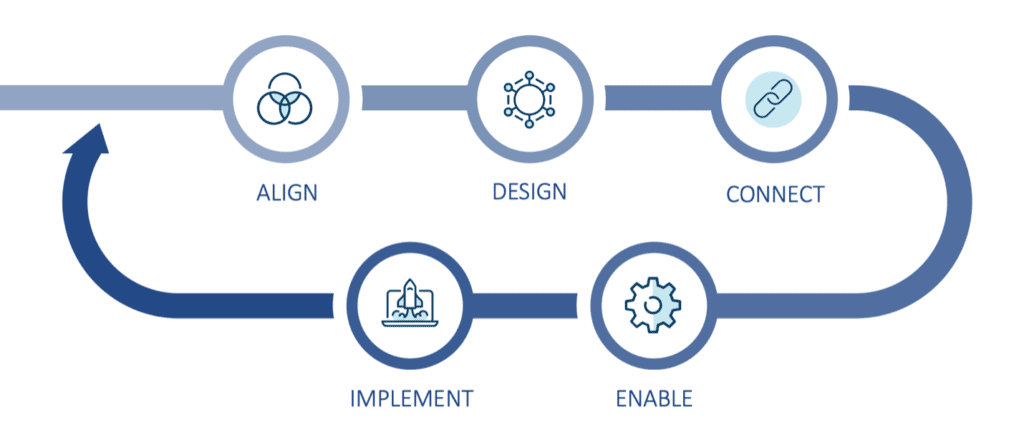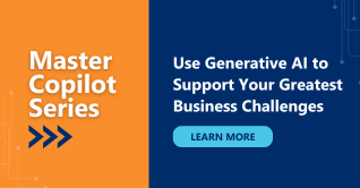For companies considering cloud modernization, they focus on moving workloads and shifting away from traditional, on-premise data centers to reduce costs and improve scalability for future growth. While these are important factors, it’s only a small piece of what is possible in a successful cloud modernization strategy. By embracing new software delivery paradigms across practices, architectures, and deployment methods, your organization can facilitate comprehensive, top-down change while maximizing impact, improving CX, and increasing the bottom line.
However, the modernization process isn’t as simple as moving pieces of your company from on-premise to a cloud platform. Even before you start building a strategy, you need to have clear answers to the following questions:
- What do we start with?
- How do we prioritize and rank projects?
-
When do we start this process?
To help you plan your modernization strategy and journey, we’re exploring the common questions and challenges many businesses face and how they overcome them.
Jump to a section:
Approaches to modernization
Getting buy-in for modernization
Prioritizing modernization efforts
Choosing which applications to modernize
The path to modernization
Leveraging cloud and API strategies to enable true digital transformation
Approaches to Cloud Modernization
There are several different approaches to shifting applications from on-premise to cloud, and it’s important to be familiar with each one before starting the process so you can make the right choice. Let’s look at the most common cloud modernization strategies from least to most mature, and you can weigh each option against the goal for the application so you can consider the best options.
1. Replatform (lift and shift)
Replatforming, or “lift and shift,” simply means you’re taking an application in its existing form from an on-premise server to the cloud. This is a fast and minimally resource intensive approach as you don’t need to modify or fix any of the existing code. However, if there are already issues with the application, moving it in its existing form to the cloud may only make those problems worse.
2. Move, then modernize
This strategy is also known as platform as a service (PaaS). In it, you run your apps on a cloud provider’s infrastructure. Developers can reuse languages, frameworks, and containers leveraging code that’s specific to the company. The downside of this approach is likely to be missing capabilities, transitive risk, and being tethered to a particular framework.
3. Modernize, then move
Your team can update the application by modifying or extending its existing code, then moving it to the cloud. This method allows you to secure the application while adoptiong the cloud characteristics of your provider’s infrastructure but does also mean incurring upfront development expense.
4. Replace with SaaS
When the requirements for a business function change quickly, replacing your existing application with SaaS may be a better option than committing to a significant rebuild or refactor. While this cloud modernization strategy is faster and may be less expensive up-front, you may face issues like inconsistent data semantics, difficult data access, and being locked into a vendor.
5. Rebuild or refactor
Rebuilding or refactoring legacy applications requires restructuring and rewriting the existing code. This is the most time and cost-intensive option and is used for large projects, like breaking up an outdated, monolithic application into microservices or leveraging containerization. Not all applications warrant this investment but doing so will often provide a long-term value.
Determining your Functions
Once you determine your overall approach, the next step is determining the vehicle by which your applications will be delivered, whether by a serverless function, container, or virtual machine. Cloud modernization ensures that your application design patterns are based on principles of scalability, statelessness, and high availability, but beyond that, there isn’t a standard rule to which option is best.
Serverless
Going “serverless” is often the most cost-effective option for most organizations. This cloud computing application development and execution model lets developers focus on writing top-quality front-end application code and business logic without having to factor in or manage backend infrastructure or servers. Once they write the application code, they deploy it to containers managed by the cloud service provider.
From there, an event will trigger the application to run and prompt the cloud provider to allocate resources to it. Once the application stops running, so does billing, ensuring your company only pays the time and resources needed during execution. Also, the cloud service provider provides the infrastructure needed to run the application and is responsible for infrastructure scalability, management, and maintenance saving your organization time and resources.
Container
A container is an abstract, self-contained fixture which holds everything needed to run an application, including code, system tools, and libraries. They are “minimalist” by design, holding only what is needed and are free of superfluous software that would slow down processing.
Like serverless computing, containers enable your development team to build and restructure applications with minimal overhead and greater flexibility, plus, they can be moved and deployed easily. However, scalability is determined by the developer in advance, unlike serverless in which the backend scales automatically. Also, containers are restricted to their host system, so a Windows container can only operate on a Windows host while an OS container can only run on an OS host.
Virtual machine
A virtual machine (VM) is a software-based computer that is hosted by a physical machine but is completely isolated from it. The VM operates independently and is configured individually for the apps you run in them with the host operating system simply acts as a foundation for VMs to run. While they use significantly more processing power, a VM allows your organization to host multiple environments, offers easy scalability, and is easy to setup and maintain.
Related article: 5 keys to planning a successful cloud implementation
Getting Buy-in for Cloud Migration and Modernization
While IT teams see the overwhelming benefits of cloud modernization, it can be difficult to gain organizational buy-in from company leadership due to the up-front costs of cloud migration and modernization. We recommend that when you’re putting together your business case for making this shift, you break down the specifics of how moving to the cloud is part of your business strategy to:
- Fight competitive threats and support developing technology that your business requires; you’ll be able to create and deploy new features faster
- Break your innovation crisis and develop new strategies that don’t rely on outdated tech stacks
- Replace your house of cards, moving away from constraints about fragility and inabilities to test properly
- Attract technical leaders rather than relying on a single specialist who is the only one capable of repairing a specific system
- Restructure, merge, and acquire new technology rather than maintain outdated versions of middleware that can become a burden on budgets.
Position cloud modernization as an opportunity to maximize your existing investments and improve your company’s ability to meet business goals. Also, consider starting with a single use case and modernizing a single app to meet it. This can build a foundation for continued efforts.
Prioritizing Cloud Modernization Efforts
Once your company is ready to move forward with modernization efforts, it can be difficult to choose how you prioritize applications to move into the cloud. Starting with legacy systems can bring immediate time and cost benefits. Because legacy applications are often highly integrated into the infrastructure, shifting them can be complicated, but using APIs to decouple them from the infrastructure can smooth the way to shifting monolithic applications into granular, cloud-based functions.
Choosing Which Applications to Modernize
Cloud migration and modernization provides organizations with an incredible opportunity to create new ecosystems with the customer at the center of all functionalities. Traditionally, front-office functions were the only areas where customer experience needed to be prioritized. However, taking a customer-centered approach throughout the modernization of each system allows you to redefine the customer relationship to gather data effectively and improve speed and efficiency.
When building your modernization strategy, consider the applications that power the customer journey across functions and departments:
Front office – Customer-facing website and mobile experiences
Middle office – Analytics and customer insight apps
Back office – Employee-shared services, including records and transactions
Starting with customer-related applications can quickly lead to positive results and buy-in for future cloud modernization projects.
The Path to Cloud Modernization
When evaluating potential cloud modernization opportunities, there are five key steps, 1) Align; 2) Design; 3) Connect; 4) Implement; and 5) Enable.

Alignment and strategy development
When building out your modernization strategy, consolidate and charter each element of the process and partner with leaders across the business. This ensures that all parties are involved, understand the project, and can provide valuable insight and input related to where to start and building an efficient path forward.
Design and adoption
Once your stakeholders are in alignment with the strategy, it’s time to define the north star for the architecture and technology. Analyze the key cloud platforms, then capture and socialize reference architecture. During this step, it’s important to evaluate the delivery method of your applications, keeping in mind how to keep architectures compatible.
Connection and Integration
While separating data can enable federation and autonomy, integration supports connection and sharing across teams. Whether you’re choosing to replatform, restructure, or replace a legacy application, consider how your apps will connect and integrate into the architecture as a whole and how you can leverage APIs to unlock modern architecture.
Enabling modernization across the enterprise
This is a cyclical process, and when you near the end of implementation, it will probably be time to start a new project. The cloud modernization process is always in flux and are rarely fully complete. As you iterate and refine the work you’re doing you’ll continue to increase your insight into the process while improving efficiency. Y
Implementation
When it’s time for implementation, it’s important to contain the risk. Make changes across your portfolio one by one. Prioritize your timeline by business case and stick to the reference architecture you built previously.
Remember that the path to cloud modernization isn’t just a straight line, it should be circular to reflect an ongoing process.
Leveraging cloud and API strategies to enable true digital transformation
Digital transformation powers innovation and increases an organization’s ability to meet and exceed customer expectations. However, for companies with outdated IT systems and legacy applications standing in the way of progress, modernization is the way forward.
Wherever you are on your organization’s journey to modernization, we’ve got resources to help you along the way. Want to talk? Just let us know.



